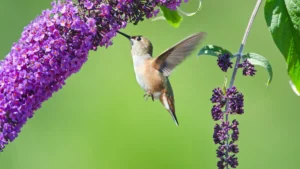If you’re looking to bring life, color, and constant motion to your garden, there’s one flower you should absolutely consider planting: bee balm. Not only is it a top choice for hummingbirds, but it also attracts bees, butterflies, and other beneficial pollinators. This vibrant flower is like a magnet for winged wildlife—and a total showstopper in any garden.
What Is Bee Balm?
Bee balm (also known as Monarda) is a flowering perennial native to North America. It comes in shades of red, pink, purple, and white. The most popular variety among hummingbirds is red bee balm, thanks to its bright color and tubular blooms that are easy for their long beaks to sip nectar from.
This flower isn’t just beautiful—it’s also tough. Bee balm thrives in many types of soil and climates, making it a reliable pick for home gardeners.
Why Hummingbirds Love It
Hummingbirds are naturally drawn to the color red and to tubular-shaped flowers, both of which bee balm offers. The flowers are packed with nectar, giving these high-energy birds the fuel they need throughout the day.
Bee balm blooms in mid to late summer, which is ideal timing during the peak of hummingbird activity. Plus, it blooms for weeks, ensuring a consistent food source.
It’s Not Just for Hummingbirds
While bee balm is a hummingbird favorite, it also brings in a wide variety of pollinators, such as:
- Bees (both honeybees and native bees)
- Butterflies
- Moths
- Even beneficial wasps
Having a mix of pollinators improves your garden’s health and helps other plants thrive.
How to Grow Bee Balm
Growing bee balm is simple—even if you’re new to gardening.
Here’s what it needs:
- Sunlight: Full sun to part shade
- Soil: Moist, well-drained
- Water: Regular watering (especially in dry spells)
- Spacing: Leave at least 18 inches between plants for airflow
- Zones: Grows best in USDA zones 3–9
Pro Tip: To prevent powdery mildew (a common issue), give bee balm plenty of space and good air circulation.
Container or Garden Bed? Both!
Bee balm grows well in garden beds and large containers. If you’re tight on space or want to add color to a patio, you can pot it up and still enjoy all the hummingbird visits. Just make sure the container is deep enough and drains well.
Benefits of Planting Bee Balm
- Attracts hummingbirds, butterflies, and bees
- Adds bright, bold color to your garden
- Deer-resistant and easy to grow
- Offers a long blooming season
- Can be used in teas (the leaves are minty and aromatic!)
Final Thoughts
Bee balm is one of the best all-around flowers for pollinator-friendly gardens. With its stunning looks and hummingbird appeal, it’s an easy way to bring more life—and beauty—to your yard. Whether you’re new to gardening or a seasoned pro, this flower deserves a spot in your space.
FAQs About Bee Balm and Pollinators
1. How long does bee balm bloom?
Bee balm typically blooms from mid-summer through late summer—around 4 to 6 weeks.
2. Can I grow bee balm in a pot?
Yes! Just choose a large container with drainage holes and keep the soil moist.
3. Is bee balm safe around pets?
Yes, bee balm is non-toxic to dogs and cats, though it’s always best to prevent nibbling.
4. Will bee balm spread in the garden?
It can spread through underground roots. To keep it in check, divide it every couple of years or grow it in containers.

